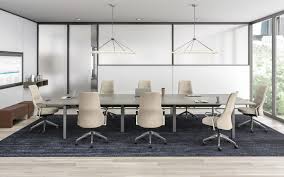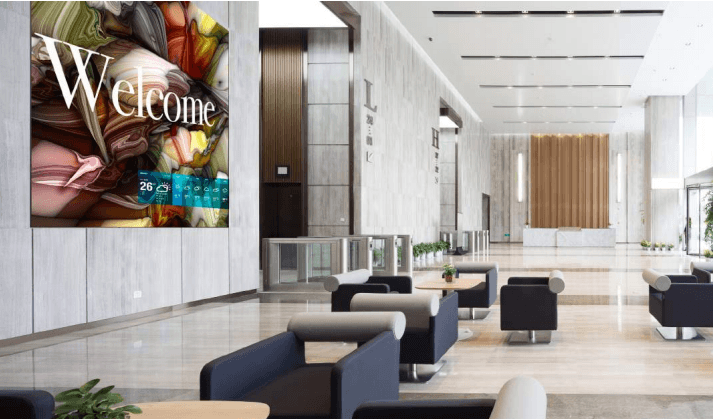Is it time to start talking about LED for boardrooms? Let’s find out.
Historically a corporate boardroom meeting would follow this format: you’d arrive at the meeting room, press ‘power’ on the control panel, the projector fans start, and the projection screen drops from the ceiling. After around 1-minute of boot up time, you’d be squinting at a hazy projector image that doesn’t quite fit the screen, followed by Keith from accounts trying to connect his laptop. After 20 minutes of cable hunting and 2 phone calls to facilities later, you’re finally underway. The lights are then dimmed, and you all hunker down in the dark only to drift off to Keith’s Excel spreadsheet…
Sound familiar? I’ve sat through my fair share of these meetings, but recently employers have been investing in office spaces which are now cleverly designed to improve morale, and more importantly, productivity. A recent survey by Future Workplace, a HR advisory firm, found that access to natural light made employees less tired and more dynamic. This trend doesn’t look good for projection which relies on low ambient brightness.

With new, interesting and bright office spaces becoming more popular, we saw the rise of the large format displays (LFD’s) eating into projection’s market share. The LFD offered a great contrast ratio with UHD resolution, with no boot-up time, in a neat, slimline, silent box. “Great!” everyone cried, but I want one that is bigger than 98” for my large meeting room, what can I have for that?” Well Mr. Customer, I’m afraid nothing – you’ll be needing a projector for that.
Having worked in the projection business for the first 6 years of my career, I’m not saying projection is dead. There are still many applications where a projector is the right solution to choose. What we’re interested in is what new technologies are out there that can be used, instead. Specifically, direct view LED.
Direct view LED has come a long way in the last 5 years. We’ve all seen it (mostly in shopping malls and above kebab shops), but in this article, we are talking about pro visual direct view LED. We are seeing some big manufacturers, like Samsung who have opened their own LED division, jumping on the bandwagon. So it seems this technology has some legs. I believe the following 5 key points differentiate LED from projection in boardroom environments:
1. LED is better for bright environments
The ambient brightness in my office is around 500 lux. If I wanted to fill a 2.5m screen at the minimum 7:1 contrast ratio I would need a 15,000 lumen projector! That’s a big noisy box I’ve got to put in my boardroom for only 7:1 contrast. Whereas LED can run at upwards of 600 nits, this means we can get way better contrast ratio even while running the wall at 50% brightness.
2. LED is less intrusive than projection
Okay, unlike a roll-up projection screen the LED screen is always there. So how is that less intrusive? There are a few things think about with LED in regards to this. LED has no fans so there is no background noise. There’s minimal heat given out from the LED and you can walk right up to the screen and not worry about casting a shadow. We could look at rear projection in this situation but that comes with its own challenges, and, come on people, it’s 2019! Furthermore, LED doesn’t need time to turn on, meaning the meeting can start the second you press “on”, connect the PC and start talking about realising synergies.
3. LED is more reliable than projection
LED has no moving parts – not one. They are as simple as a diode on a printed circuit board. This means they have an incredibly low failure rate. Manufacturers are stating that their LED will do 100,000 hours to half brightness. This equates to running 27/7 for 11.5 years! When looking at projection we need to think about fans and illumination technology. Fans fall under ‘consumables’ with most projector manufactures. This means you’ll pay for the fan and for a technician to come and repair it so the room will out of action until repaired. Also, depending on whether you go with lamp or laser projectors, you need to think about how much it would cost to keep that projector running at optimum brightness. Hassle!
4. Projection tends to be higher resolution
We live in an age where the news in Japan is broadcast in 8K. I mean, once you’ve watched the news in 8K there’s no going back to a lowly 4K! But the fact is customers want higher resolutions and that’s tough to do with the current crop of LED due to the pixel pitches available. Many projector brands can do 4K or 4K simulation in a relatively low price. Personally, I still think HD looks pretty good! But maybe I’m getting old.

5. Cost
Projection is the cheaper option. But with the rise of LED we are seeing more manufacturers looking to get a slice of the pie. This is adding competition and driving down prices which is good for the customer. Even now, we are seeing that LED is more financially accessible than ever before.
So, is it time to start talking about LED for boardrooms? Yes, absolutely. The benefits of switching to LED are clear to see. Imagine walking into a meeting room filled with natural light, seamlessly connecting your laptop and collaborating instantly on a stunning LED wall. LED is the latest
advancement in visual technology and has been designed to overcome the shortfalls of what has been before.
If you’re thinking about spending a large sum of money on designing a bright and interesting office environment, why would you select a display that would undo all that hard work? Your LED wall will be the showpiece of the boardroom or lobby, leaving a great and lasting impression on clients and customers.
If you would like to learn more about how LED can benefit you or any other AV related queries, drop me an email at tkinch@involve.vc

